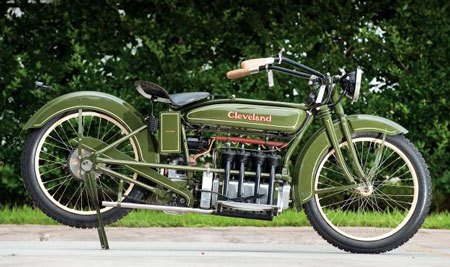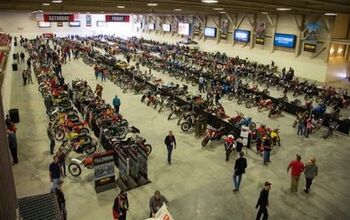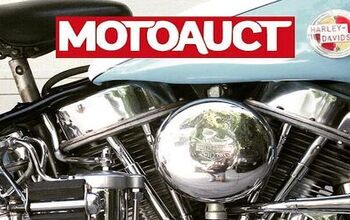2010 Hershey Vintage Motorcycle Auction
Although the economy is on shaky legs, two-wheels are apparently much more stable, especially when you’re considering investing in precious metals or keeping up to date on that bike gathering dust in your garage. Gold has jumped to over $1,200 an ounce and there’s plenty of that to be found in “golden classics,” case in point the four bikes seen here among several other classics cars and bikes about to go up on the auction block via RM Auctions, in this case the venue being Hershey, Pa., historic home to decades of bike and car shows.
The Cleveland Four
Some of the bikes, including the Cleveland Four had been in the collection of the late mega-collector Otis Chandler and once displayed in his Oxnard, Calf., museum before they moved on to the John O’Quinn collection. Added panache for the Cleveland Four seen here is accrued by its purported membership in Steve McQueen’s much vaunted collection, McQueen said to have purchased it at a swap meet in 1977. It eventually passed into the hands of McQueen’s longtime friend, motorcycling icon Bud Ekins, then onto to Chandler’s collection.
The machines of the Cleveland Motorcycle Manufacturing Co. were built, where else, but in Cleveland, Ohio. Founded in 1915, the company made a smart move when it hired car engineer L.E. Fowler who designed its all new four-cylinder machine. While its first efforts for 220cc transverse mounted two-stroke signals and later a 350cc four-stroke, the Four, introduced in 1925, was a quantum leap in all senses of the word.
Displacing 600cc, the T-head Four was a sidevalve design, intake cam on the left, exhaust cam on the right, the smooth running powerplant mated to a 3-speed tranny. Its handling benefited from the low center of gravity afforded by the placement of the engine above the crankcase in the perimeter cradle frame. It rarity is enhanced by the fact that the 600 was soon transplanted by the larger displacement 750cc model resulting in the building of only 100 of the 600 models. Word is that this bike, of 1926 vintage, could well be the only complete example still in existence. Expectations for the final selling price at the RM auction are $60,000-$80,000.
The Exceptional Excelsior
While many of the early bikes bore the name of their builders such as Harley-Davidson, Curtis, Merkel and Henderson, others have a less egocentric origin. The Excelsior got its name from the Latin “excellus” roughly translating to “higher and superior.” It also came to mean the curled wood shavings used in packing fragile items. The 1913 racer fits into both meanings, exceptional quality in a delicate assemblage. During its heyday it battled its major competitors Harley-Davidson and Indian for boardtrack glory, and often as not garnering splinters for its riders when they sometimes crashed on racecourses fashioned from wooden planks.
Born in Chicago in 1907, the American Excelsior (the Germans and English had their own Excelsiors) was a subsidiary of no less a legend that Schwinn bicycles dynasty (and eventually the equally legendary Henderson four-cylinder machines). Eventually Ignaz Schwinn would shoehorn 30-cubic inch single and 45- and 61-cbuic inch V-Twins into his beefed-up bicycle frames. The first models, 499cc two-stroke powered, when sent to Europe were labeled American-X, then Super-X so as not to confuse them with the Continental manufacturers using the same name. Reaching speeds of 100 mph, Excelsior racers could well be called the first “X-Men,” superheroes of a bygone era.
Seen here is a 1930 Excelsior Super X Streamliner V-Twin built during the final year of Excelsior production, and has been restored to concours standards, such that it was featured at the Guggenheim Museum, then acquired by legendary collector Chandler who displayed the Super X in his famed collection until 2006, when it went to the John M. O’Quinn - and now about to go some lucky new owner via the RM auction for somewhere in the $30,000-50,000 range.
1911 Flanders 4
Propelled by a 485cc Single Cylinder/4 HP engine set in a frame with a 55.5 inch wheelbase and rolling on 28-inch wheels, the Flanders 4 (a reference to its horsepower) weighed just 170 lb. it could reach 45 mph, and was considered poetry in motion and quite startling when viewed by pedestrians of the day. 5 hp, 363 cc air-cooled inline four-cylinder engine, shaft drive, and rear drum brake.
First rolling out of the Detroit-based Flanders Motorcar Company in 1911 the handsome machine with its ”whale shaped” underslung gas tank and graceful tiller handlebars was officially labeled as the Flanders 4, the number referring to the horsepower produced by its 485cc single cylinder powerplant. It was a motorcycle that made waves when introduced.
A large ad appearing on page 8 of the Sunday July 7, 1912 issue of the Galveston Daily News stated, “Flanders “4” Motorcycle Has Them All On The Run. $175 f. o. b. Factory - Magneto Included of Course. What an upsetting of prices the arrival of the Flanders “4” Motorcycle has occasioned. Why, the other makers seem to be in a panic. It’s funny, too, when you recall the unkind things they said about -the Flanders "4" when we first advertised it and stated the price. Of course they said, a first-class four-horsepower motorcycle could not he made for $175, even with battery ignition. And a magneto included - utterly impossible. We wish we could print all the things they said in their frantic efforts to discredit the Flanders "4" and justify their own prices which at that time were $250 and $275 for machines of same power and less quality. We can build 60,000 a year at a $175 price.”
Although the low price was correct, the massive output of machines predicted was equally optimistic. As a result today they are few in number and far between. The concept behind the Flanders was based on most bang for your buck, the design and construction of a reliable, comfortable machine with a price tag friendly to the pocket book and substantially less than the competition. While it was value priced it did not skimp on the refinements. As a case in point was the compression and rebound dual spring design of the front fork. Other advanced features included a Splitdorf magneto.
The Flanders 4 was an enterprise born of a largely successful automobile manufacturer, the Everitt-Metzger-Flanders Company founded in 1908 and the producer of some stylish automobiles (some 30,000 sold), both gasoline and electric powered. Walter Flanders himself had previously been employed by Henry Ford and was said to be responsible for setting up the assembly line system that would make Ford an international success. Flanders would also incorporate the principle of mass production into both his cars and bikes, thus lowering their price. Then in 1911 E-M-F was bought by the Studebaker Co. and the last of the Flanders motorcycles, in production for three short years, was produced in 1914. RM auctioneers expect to see $40,000-$60,000 US.
1905 FN Type A – First of Its Kind
The Belgian built bike by a company known then and now for its advanced rifles, Fabrique Nationale d’Armes de Guerre, the 1905 FN claims the title of the very first “practical” four-cylinder motorcycle design, specifically a 363cc inline, air-cooled four producing a stout 5HP and also featuring shaft drive although sans clutch and gearbox, thus direct drive. While the company had ventured into bicycles and motorcycles just three years previously in 1902 with a 133 and 188cc singles, it stepped up big time when it launched a “secret project” directed by engineer Paul Kelecom. His goal, to produce a motorcycle engine free of the vibration that haunted previous large singles. Testing proceeded at the 1905 Paris Salon and proved successfully.
The design included an atmospheric or automatic inlet valve, five main bearing crankshaft and advanced lubrication. The bike’s acclaim reached the shores of the U.S. where it became very popular and many consider it to be the motivating genesis for the all-American four-cylinder designs to follow, from Pierce to Indian. This restored example features a self-contained acetylene headlight and a beautiful embossed brass fuel tank. The projected sales price by RM Auctions anticipates an estimated $40,000-60,000.
If you want to follow the action and tally up the final figures, this event takes place Oct.7-8, and bidding is available on the Internet or by phone. More info at http://www.rmauctions.com/.
More by Paul Garson


































Comments
Join the conversation